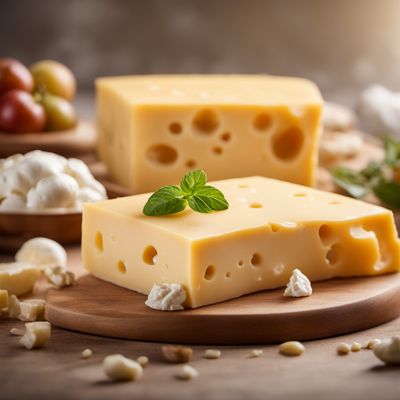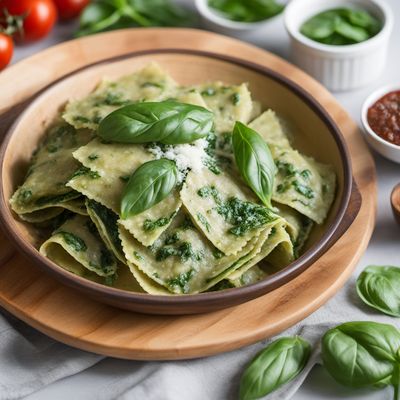
Ingredient
Extra hard cheese (parmesan, grana type)
"The King of Cheeses: Exploring the World of Extra Hard Cheese"
Extra hard cheese, like Parmesan and Grana, is characterized by its firm and granular texture, which crumbles easily. It has a pale yellow to golden color and a distinct nutty, savory, and slightly fruity taste. The cheese is aged for an extended period, resulting in a hard and dry texture that is perfect for grating or shaving. Its intense flavor profile adds depth and complexity to a wide range of dishes, making it a staple in Italian cuisine and beyond.
Origins and history
Extra hard cheese has its roots in Italy, with Parmesan and Grana Padano being the most famous examples. Parmesan originated in the Emilia-Romagna region, while Grana Padano hails from Lombardy. Both cheeses have a long history, dating back to the Middle Ages, and were initially created as a way to preserve surplus milk. Today, they are protected by strict regulations and are considered iconic symbols of Italian gastronomy.
Nutritional information
Extra hard cheese is a rich source of protein, calcium, and phosphorus. It also contains essential vitamins like vitamin A and vitamin B12. A 1-ounce (28g) serving of Parmesan cheese provides approximately 110 calories, 7g of fat, and 10g of protein.
Allergens
Extra hard cheese, such as Parmesan and Grana, may contain lactose and is not suitable for individuals with lactose intolerance or dairy allergies.
How to select
When selecting extra hard cheese, look for a well-aged cheese with a hard and dry texture. Avoid cheeses with any signs of mold or excessive moisture. Opt for whole pieces rather than pre-grated cheese to ensure freshness and quality.
Storage recommendations
To maintain the freshness and quality of extra hard cheese, store it in the refrigerator in a tightly sealed container or wrapped in wax paper. Avoid plastic wrap as it can trap moisture and affect the texture. Properly stored, it can last for several months.
How to produce
Producing extra hard cheese requires specialized knowledge and equipment. It involves the process of curdling milk, separating the curds, pressing, and aging the cheese for an extended period. It is best left to professional cheesemakers.
Preparation tips
Extra hard cheese is incredibly versatile and can be used in various ways. Grate it over pasta, risotto, or salads for a burst of flavor. Shave it onto soups or roasted vegetables to add a finishing touch. It can also be enjoyed on its own or paired with fruits and nuts for a delightful cheese platter. To enhance its flavor, bring the cheese to room temperature before serving.
Substitutions
A suitable substitute for extra hard cheese like Parmesan or Grana is Pecorino Romano, which has a similar hard texture and sharp flavor.
Culinary uses
Extra hard cheese, such as Parmesan and Grana, is widely used in Italian cuisine. It is a key ingredient in dishes like pasta carbonara, risotto, and Caesar salad dressing. It is also a popular choice for grating over pizza, soups, and roasted vegetables to add a savory kick.
Availability
Extra hard cheese, including Parmesan and Grana, is commonly available in Italy and can be found in specialty cheese shops and gourmet grocery stores worldwide.
More ingredients from this category » Browse all

Cheese, caciocavallo
The Versatile Italian Delight

Cheese, sbrinz
The Alpine Delight: Sbrinz Cheese

Cheese, formai de mut
The Aged Treasure

Cheese, pecorino romano
The Bold and Savory Delight: Pecorino Romano Cheese

Cheese, grana padano
The King of Italian Cheeses: Grana Padano

Cheese, comte
The King of French Cheeses

Cheese, fiore sardo
The Sardinian Delight: Fiore Sardo Cheese

Cheese, san simon
The Smoky Delight of San Simon Cheese

Cheese, ragusano
The Sicilian Delight

Cheese, ubriaco
"Aged to Perfection: Exploring the Unique Flavors of Ubriaco Cheese"

Cheese, afuega'l pitu
The Fiery Delight: Exploring the Bold Flavors of Afuega'l Pitu Cheese

Cheese, bitto della valtellina
Bitto della Valtellina: The Alpine Delicacy
Recipes using Extra hard cheese (parmesan, grana type) » Browse all

Zampone Modena with Savory Herb Stuffing
Savory Stuffed Zampone Modena: A Delightful Italian Culinary Tradition

Homemade Potato and Cheese Pierogi
Savory Pillows of Polish Delight: Potato and Cheese Pierogi

Timballo di Melanzane e Ricotta (Eggplant and Ricotta Timballo)
Sicilian Delight: Layers of Eggplant and Ricotta in a Timballo

Fettuccine Burro e Parmigiano
Creamy Parmesan Pasta Delight

Authentic Brazilian Cheese Bread Recipe
Cheesy Delights: Authentic Brazilian Pão de Queijo

Italian-style Spring Rolls
Deliziosi Rotoli di Primavera Italiani (Delicious Italian Spring Rolls)

Homemade Spinach and Ricotta Ravioli
Savory Delights: Handcrafted Spinach and Ricotta Ravioli

Perrerreque - Colombian Cheese Bread
Savory Delight: Colombian Perrerreque Cheese Bread

Garlic Risotto
Creamy Garlic Delight: A Twist on Traditional Italian Risotto

Creamy Italian-style Scrambled Eggs
Velvety Eggs: A Taste of Italian Comfort

Fettuccine Burro e Parmigiano
Cuban-inspired Creamy Pasta Delight

Creamy Mushroom Risotto
Mushroom Delight Risotto: A Creamy Italian Masterpiece